|
Disability Features
All MRT stations have been
installed with disability facilities as of 2006. These
include lifts, ramps, wide fare gates, a tactile guidance
system and handicapped-friendly toilets.
For elevated stations, the
tactile path starts right at the ramp entrance to the
station and brings the visually-handicapped through the wide
fare gate and into the
lift at the concourse level. The tactile path may
diverge at
the concourse level to lead to the handicapped-friendly
toilet or passenger service centre. Upon exiting
from the lift at the platform level, the tactile path will
lead them to a designated waiting area near the doors of the
train which are nearest to the lift, where they will
wait to board the train. In elevated stations where platform
screen doors are not installed, tactile studs are also
installed along the entire stretch of the platform edge
in addition to a yellow line to warn them not to get too
close to the edge.
For underground stations,
the tactile path starts at the ramp entrance to the station
and brings the visually-handicapped into the lift and down
onto the concourse
level, where the path may diverge towards the passenger
service centre or the handicapped-friendly toilet. From
there, the path continues past the wide fare gate
and into another lift which brings them onto the platform
level. The path leads them to a series of platform screen
doors nearest to the lift, where they will wait to
board the train.
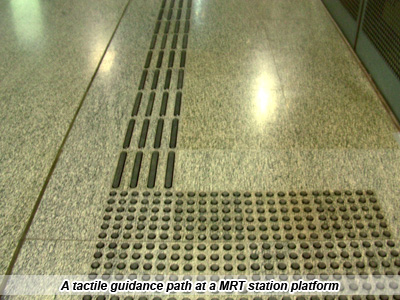
Back To Top
The older stations on the
North South Line and East West Line were not installed with
wide fare gates when they were first built in the 1980s and
1990s. From April
2002 however, wide fare gates have been progressively
installed in all MRT stations as part of a programme to make
it easier for those with bulky items such as
luggage and prams to get to and from the platforms,
especially since the MRT had been extended to Changi
Airport
to serve air travellers. This programme was also
introduced to retrofit all MRT stations with
disabled-friendly facilities, allowing the
wheelchair-handicapped to be able to access the MRT. The
programme has since
been completed. Each station has been equipped with at least
one wide fare gate, with gates in selected stations such as
Changi Airport station having all of the wide
variety.
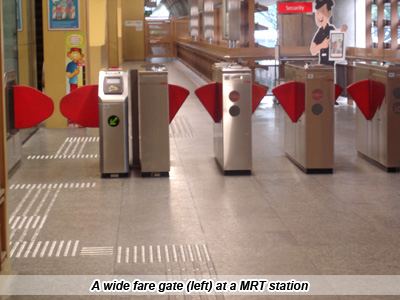
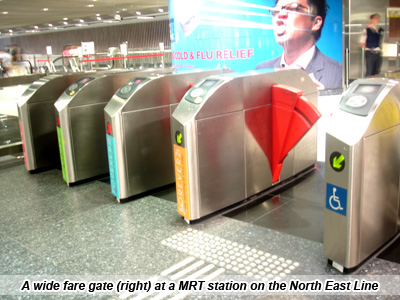
Back To Top
The older stations on the
North South Line and East West Line also did not have
barrier-free facilities such as lifts and ramps incorporated
into their designs. As of
2006, all stations have been retrofitted with barrier-free
facilities as part of a programme to make all MRT stations
accessible to the elderly and the
handicapped.

Back To Top
OTIS is the supplier for
the lifts at Changi Airport station and the ones at
stations
on the North East Line, while Chevailer who is the
distributor for Toshiba elevators
in Singapore supplies lifts for all other stations on the
North South Line and East West Line. These lifts typically
have a capacity for 15 passengers with a total load of
1000kg, although those at interchanges or busy stations are
designed with a larger handling capacity. The lifts feature
Braille plates on lift buttons, audio
announcements & LED displays.
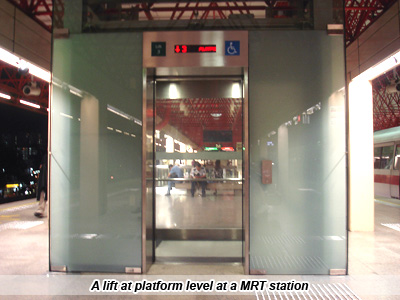
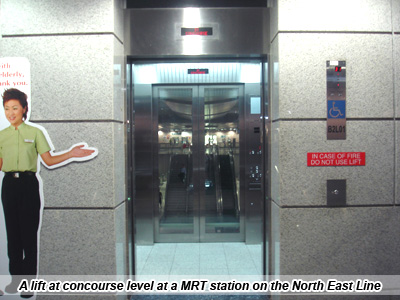
Back To Top
Handicapped-friendly
toilets are present at every MRT station to make it easier
for the elderly and the handicapped to use the toilet. There
are grab poles and other
handicapped-friendly facilities installed to help them move
about in the toilet. The toilet has also more space for the
wheelchair-handicapped to move, allowing them
to have more convinience and ease when using the toilet.
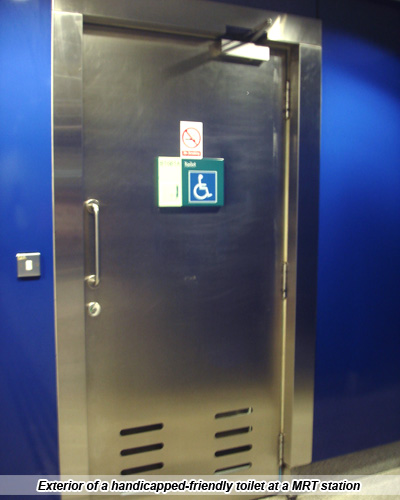
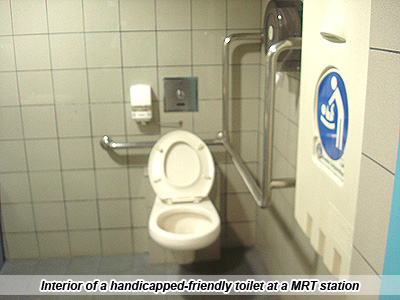
These disability features
of MRT stations significantly help Singapore solve its
ageing population problem by allowing the elderly and the
handicapped to move about
easily and be able to take public transport around the
island. MRT stations are now accessible to one and all, with
the implementation of disability facilities in the
stations.
next: Rolling Stock
Back To Top
|